October 2023
The Pattern Game
Dr. Jessica Cantlon’s research team is investigating how children learn abstract concepts and logical rules. Children play a simple game in which they are encouraged to discover a matching rule; they choose a pattern of fruit from two options to match the sample pattern. An example of this is shown below:
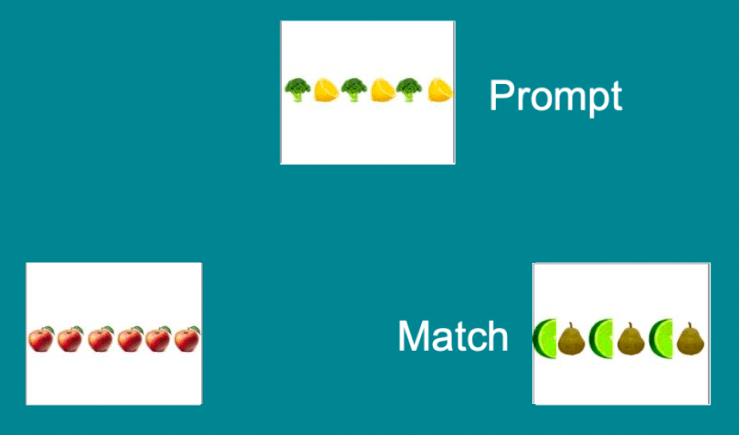
This game will help the researchers understand how children represent patterns (alternating vs. same) across different (but all familiar fruit) objects. The purpose is to study the development of abstract pattern reasoning and counting over sets and sequences to understand how high-level logic emerges in humans. One theory is that humans track abstract patterns spontaneously, beginning in early childhood, and a second theory is that humans build these capacities gradually in parallel with language development. This study will allow us to better identify which of these theories is more accurate.
The Picture Game
Dr. Jessica Cantlon and graduate student Abhishek Dedhe are investigating how children use simple logical rules to process complex visual patterns. This game happens over several sessions. Researchers teach the child to complete two tasks involving visual patterns: shapes and brackets. Both tasks rely on logical rules about repetition, hierarchies, and symmetry. By having the child perform these challenging tasks, researchers can examine how the child’s understanding of these logical rules improves. A visualization of the bracket task is included at the bottom of this page. The shape task looks very similar, except that it has unknown shapes that look like keyboard characters (@, !, #) instead of brackets.
In the Picture Game, the child completes two tasks. Since each child progresses at their own speed, they might need more than one session to complete them. First, researchers teach the child the correct order of a sequence of four shapes or brackets. These four shapes or brackets are shown scrambled on the screen, and the child touches them in the correct order. Our robot friend Rajah helps the child know if they're on the right track. Once researchers establish that the child has understood the task, they are shown sets of scrambled shapes or brackets and asked to select them in the correct order. However, this time Rajah does not tell them whether they are right or wrong.
Bracket task:
For example, in one bracket task, the child is told that these four brackets occur in the shown order (first - second - third - fourth). They are then shown the following four scrambled brackets and asked to touch them in the correct order. In this case, there are two equally correct orders.
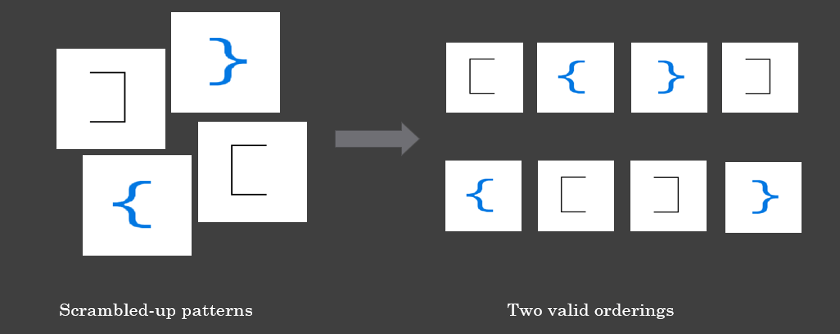
The Additional Picture Games
Researchers play additional games with the children to determine whether their Picture Game performance is related to any other cognitive process, such as working memory, motor skills, and language comprehension. They assess working memory because the more a child can remember the visual patterns in their heads, the easier the game should be. They are also checking whether the child can utilize these simple logical rules based on repetition, hierarchies, and symmetry in domains unrelated to vision. These domains include language and movement. All these tasks provide researchers with context when they examine results from the Picture Game. This context allows them to be more confident about the meaning of their research findings. It might even reveal some connections they might not have expected!
- In the Zoo Locations Game, researchers have zoos with different amounts of exhibits, each with different animals. After viewing the zoo’s arrangement, children are given an empty zoo and asked to place each animal where they belong. This task checks children’s working memory.
- In the Picture Memory Game, children see a picture of several common objects (like an apple or a kite) and then another picture with those same objects mixed with others. Researchers then ask them to point to the objects they saw on the prior page. This task also examines working memory, but in a slightly different way. Using both games together provides a clearer measure of children’s working memory ability.
- In the Number Game, researchers ask the child to listen to a list of numbers and then repeat them both in forward and backward order. This task also taps working memory, but unlike the zoo location and picture memory games which measure visual working memory, this game measures verbal working memory.
- In the Language Comprehension Game, researchers show the child a picture of several colored shapes and ask them to point to specific objects they see (such as “the second small green circle”). This task allows us to examine general language comprehension (does the child know the meaning of “green” or “circle”?), as well as examining how the child combines different words to grasp the overall meaning (such as the difference between a “small circle”, a “green circle”, and a “small green circle”).
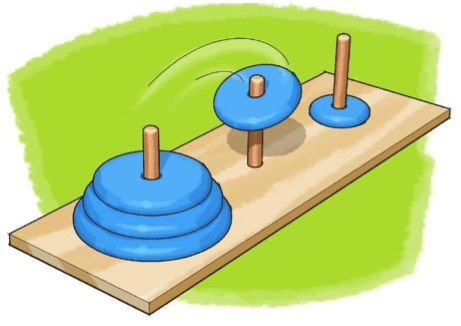 In the Tower of Hanoi Game, the child uses a classic toy consisting of movable disks that can be slid onto wooden poles. Researchers ask the child to move the disks from one pole to another according to certain rules (such as “you cannot put a bigger disk on a smaller disk”). This task examines whether your child can plan their future moves so that they satisfy specific conditions.
In the Tower of Hanoi Game, the child uses a classic toy consisting of movable disks that can be slid onto wooden poles. Researchers ask the child to move the disks from one pole to another according to certain rules (such as “you cannot put a bigger disk on a smaller disk”). This task examines whether your child can plan their future moves so that they satisfy specific conditions.- In the Corsi Block-Tapping Game, children are shown a screen display of up to nine identical spatially separated blocks. A researcher will tap on the blocks in a particular sequence and the child’s task is to tap them in the same order. The sequence starts simple, usually with only two blocks, but it becomes progressively more complex. This task assesses the child’s visuo-spatial short-term working memory.
November 2023
Many lab experiments in cognitive science and child psychology occur in carefully-controlled lab environments. While useful to the researchers for gathering quality data, these experiments involve removing children from the natural environment of the classroom. The Kid Neuro Lab is experimenting with leveraging data obtained from in-class experiments that are incorporated as short activities in the child's daily routine. This approach means that subjects are around other children in a classroom setting, which makes the tasks "ecologically valid", i.e., more conducive to studying how exactly child learning and development occurs in the real world. The two pilot projects being conducted by Psychology Department doctoral student Abhishek Dedhe are:
The Numerical Estimation Game
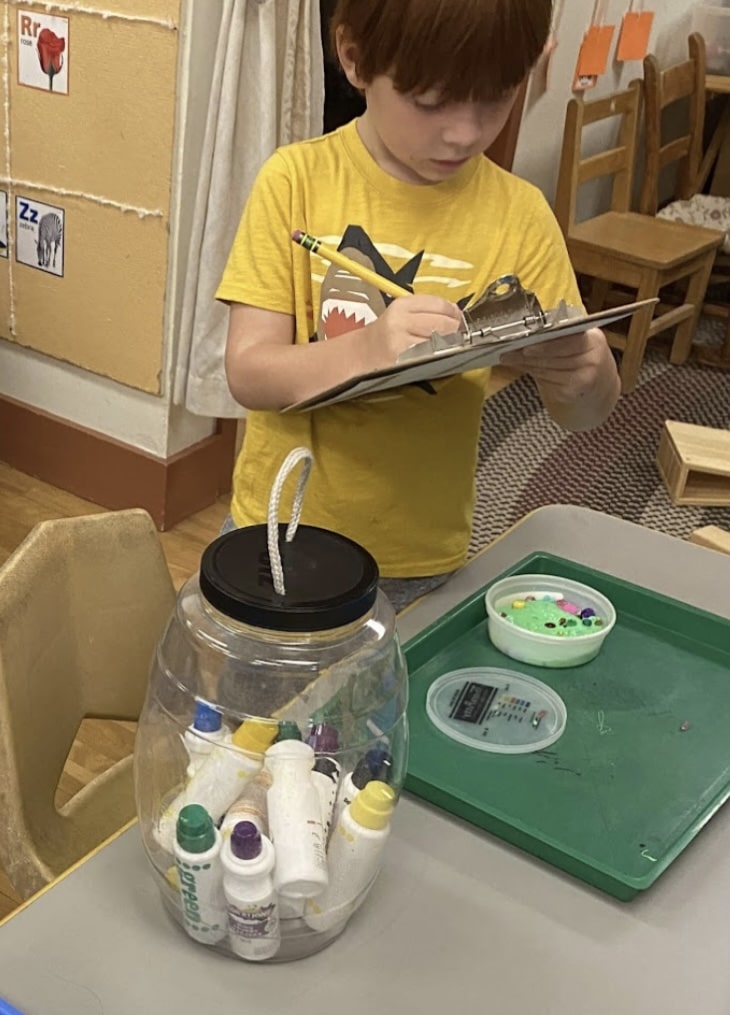 In the Numerical Estimation game, children are shown a large jar full of classroom objects (e.g., crayons, marbles, toy cars, keys, etc.). The researcher then asks the child to produce a numerical estimate - a guess - about the number of items in the jar. This task assesses both individual numerical estimation ability, as well as the potential benefits drawn from collective numerical estimation - the "wisdom of crowds". The task is very similar to the PreK/Kindergarten weekly job of “Guessing Jar Helper”, shown here.
In the Numerical Estimation game, children are shown a large jar full of classroom objects (e.g., crayons, marbles, toy cars, keys, etc.). The researcher then asks the child to produce a numerical estimate - a guess - about the number of items in the jar. This task assesses both individual numerical estimation ability, as well as the potential benefits drawn from collective numerical estimation - the "wisdom of crowds". The task is very similar to the PreK/Kindergarten weekly job of “Guessing Jar Helper”, shown here.
The Drawing Game
In this task, children are shown pictures of houses or tree-structures (shown below) and asked to draw/reproduce these pictures using a pen and paper. By tracking the order in which the child draws various elements of the picture (e.g., houses, doors, etc.), as well as whether they faithfully draw all elements, researchers may be able to discover how hierarchical reasoning develops in early childhood. Hierarchical reasoning is a complex cognitive ability involved across areas like mathematics, music, language, computer programming, and many everyday activities that involve planning well-structured sequences (e.g., a dance routine or a coordinated team gameplay in sports).
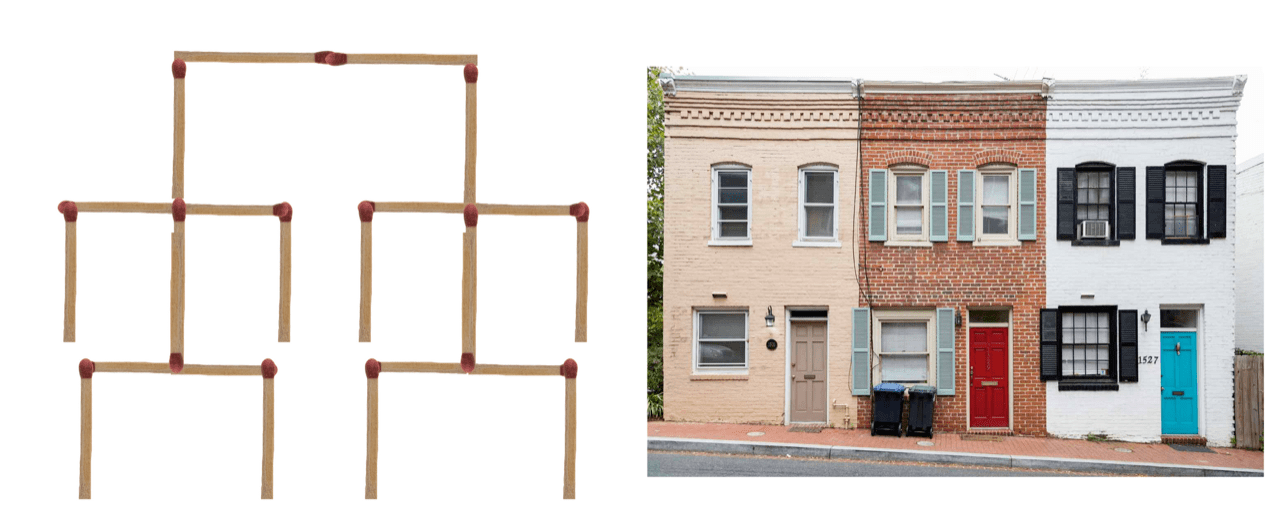
January 2024
Undergraduate Research:
Naturalistic Observations for Principles of Child Development
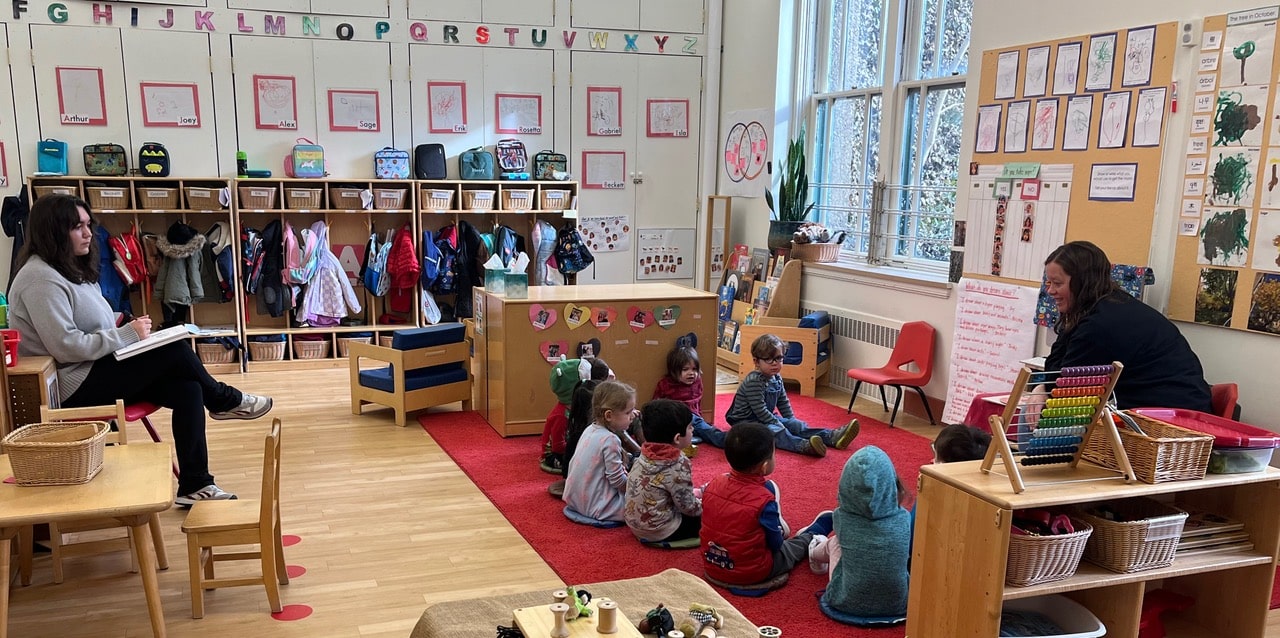
Dr. Carver’s Principles of Child Development class will conduct two sets of observations this semester. The topics are based on the acclaimed documentary series, “Becoming You” on development in the first 2,000 days of life. For each assignment, they will observe specific differences between preschoolers and kindergartners in thinking, moving, or talking for the first round of observations, and then feeling, identity, or making friends for the second round.
Research Methods Class Studies
Dr. Catarina Vales is teaching the spring Developmental Research Methods class, which will be conducting laboratory research this semester. In mid-February, the student researchers will be collecting data for a class project on the role of working memory in helping children switch their attention. All humans perseverate. Adults will sometimes search for their keys or wallet in a location they have already checked or will drive a familiar route, forgetting to make a detour for an appointment or errand. Children are more likely than adults to repeat habitual behaviors when they are no longer appropriate, and young children especially so.
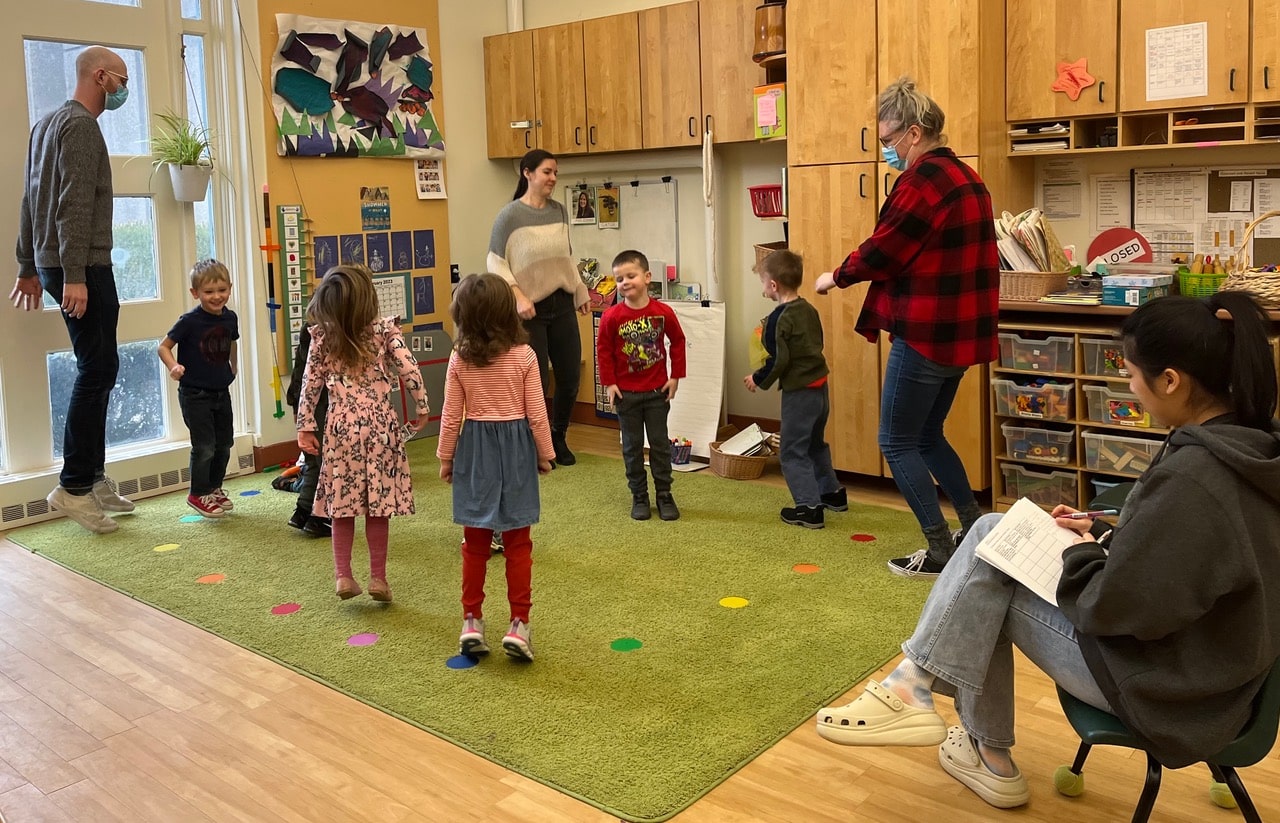
In this course project, students will replicate a previous study that examined these perseverating behaviors with a commonly used task, called the dimension change card sort task. The cards have two dimensions – shape and color (e.g., blue bunnies or boats and red bunnies or boats). Children are first asked to sort these cards by one dimension (e.g., color). Prior research indicates that 3-year-old children are likely to continue sorting by this dimension even when asked to switch to sort cards by the other dimension (e.g., shape). Prior research also shows that by 5 years of age, most children can successfully switch sorting dimension when asked. To expand the study, the undergraduates will add two types of intermediate trials between the sets where children sort by the two different dimensions. They will either provide direct instruction on the switch rule or guided visual practice to see whether either of these supports might help the younger children effectively switch sorting dimensions. Their hypothesis is that the guided practice condition will be more effective because it places fewer constraints on working memory relative to the direct instruction condition that requires children to actively hold information in mind. The results will be informative to theories of working memory and attention and also have implications for the best ways to elicit specific behaviors from young children. When children need to overcome the tendency to perseverate on a no-longer useful behavior, scaffolding the new behavior may be more useful than providing repeated direct instruction.
Later in the semester, the students will work in small groups to conduct a study of their own design, which will be approved both by their instructor and by Dr. Carver. Watch for their research questions in an upcoming weekly news post!
February 2024
The Story Game
Dr. Erik Thiessen’s research team in the Infant Language and Learning Lab is examining how children understand story sequencing to determine whether their expectation of stories affects their ability to recognize how story events are connected.
During the session, a research assistant reads the child printed versions of Nolan’s Safari and A Reef Tale, both written by Felicia Truong. One story is read in its correct order, and the other story in a manipulated order. The child is instructed to follow along with the book as the researcher reads the story aloud.
After each story, the researcher asks the child questions involving the images from the story. To assess the effects of story order, the questions are about the order in which they saw the events appear in the story (which came first?) and then answers are scored for accuracy.
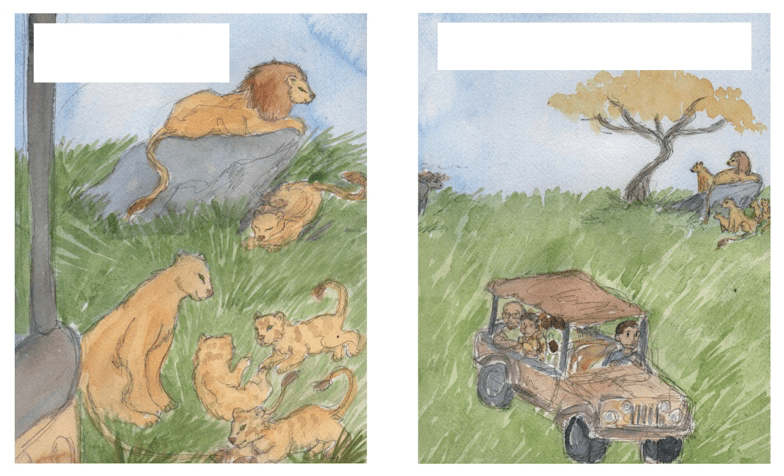
The results of the study may help researchers understand the features of a storybook that facilitate story comprehension, which may also relate to how children understand chronological orders and sequences in their everyday lives. Children’s routines form their foundational knowledge about the structure of the world that allows them to navigate it more effectively, in much the same way that knowing how restaurants work allows us to peruse a menu more efficiently.
The researchers are interested in whether children’s developing knowledge about sequence order, and the way things typically work in stories, will influence them to remember the story differently, especially in situations where they heard stories in which the order of events violates the expected sequence. From children’s responses, researchers may be able to determine the extent to which children are passively absorbing information, and the extent to which they are applying their own creative sensibilities to the material.
Reading and storytelling are a huge aspect of human life, and especially so in childhood, where books and stories provide children with an opportunity to learn and improve important skills like reading. These results will contribute to a broader effort to understand the most effective modes of storytelling and, thereby, improve children’s reading experiences.
March 2024
The Missing Piece Game
Megan Matsko, a senior working with Dr. Erik Thiessen in the Infant Language Learning Lab, is conducting her thesis research examining the uptake of feedback based on children’s confidence in matrix tasks. Cognitive research has shown that external feedback is generally beneficial for learning; however, in some cases feedback can have a negative or neutral effect on learning. Additionally, our beliefs about how well we are performing in a task, such as our confidence in a given response, have been shown to affect our attention. Therefore, understanding a learner’s confidence might help explain why sometimes feedback is not beneficial for learning. For example, some studies have shown that people listen to feedback more when they are highly confident in their responses.
For this study, the researchers aim to test the relationship between children’s confidence in their response and their learning from feedback in an analogy reasoning task. On each trial, the child is asked to decide which of the given options satisfies the analogical pattern in the matrix. The child is then asked how sure they are in the answer by selecting from faces ranging from smiling to frowning. Following this, the child is either provided 1) a correct/incorrect indication with elaborative feedback on how to solve the problem, 2) only a correct/incorrect indication, or 3) no feedback at all.
Low confidence would typically indicate that a child is unaware of how to solve a particular problem. If results show that elaborative feedback for children with low confidence is beneficial for their learning, perhaps feedback on the correct way to solve the problem is key. On the other hand, if no feedback with low confidence is better, it may be better for children to think through their mistakes and try to understand how to solve the problem through their own thought process rather than being given the extra direction. By understanding the relationship between confidence and feedback, feedback can be adapted to more specifically fit individual needs both in schools and in everyday life.

Research Methods Final Projects
The students in Dr. Caterina Vales’ Research Methods class have proposed, piloted, and begun conducting their small group final projects for the semester.
The Tangram Game
One group is exploring 3 to 6 year old children’s responses to a puppet making mistakes. In some cases, the mistake is in the context of playing a tangram game in which players take turns placing pieces in a tangram puzzle. In the other case, the puppet is not playing the game but rather interrupts the game to “show the child something” and then places incorrect tangram pieces. The research team hopes to learn whether and how children of different ages protest or indicate awareness of the puppet’s tangram mistakes and whether their responses are different when the puppet is explicitly a player in the turn-taking game or a bystander.
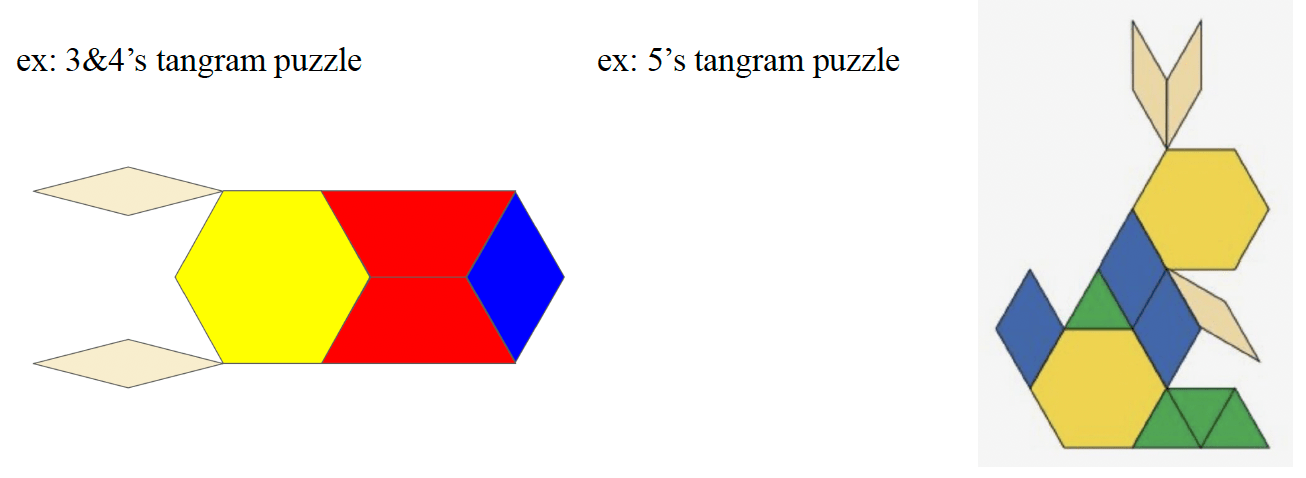
The Attention Game
One group is investigating the effects of television distraction on children’s attention and cognitive performance on lego and tangram building tasks. Preschool 3’s, Preschool 4’s, and Kindergartners will work on the building tasks while a children’s television program, Helpsters, plays in either high or low video saturation, and they will either receive occasional prompts to stay focused on the lego and tangram tasks or not. The research team hopes to learn how distractibility changes with age and how effective focus prompts are at different ages.
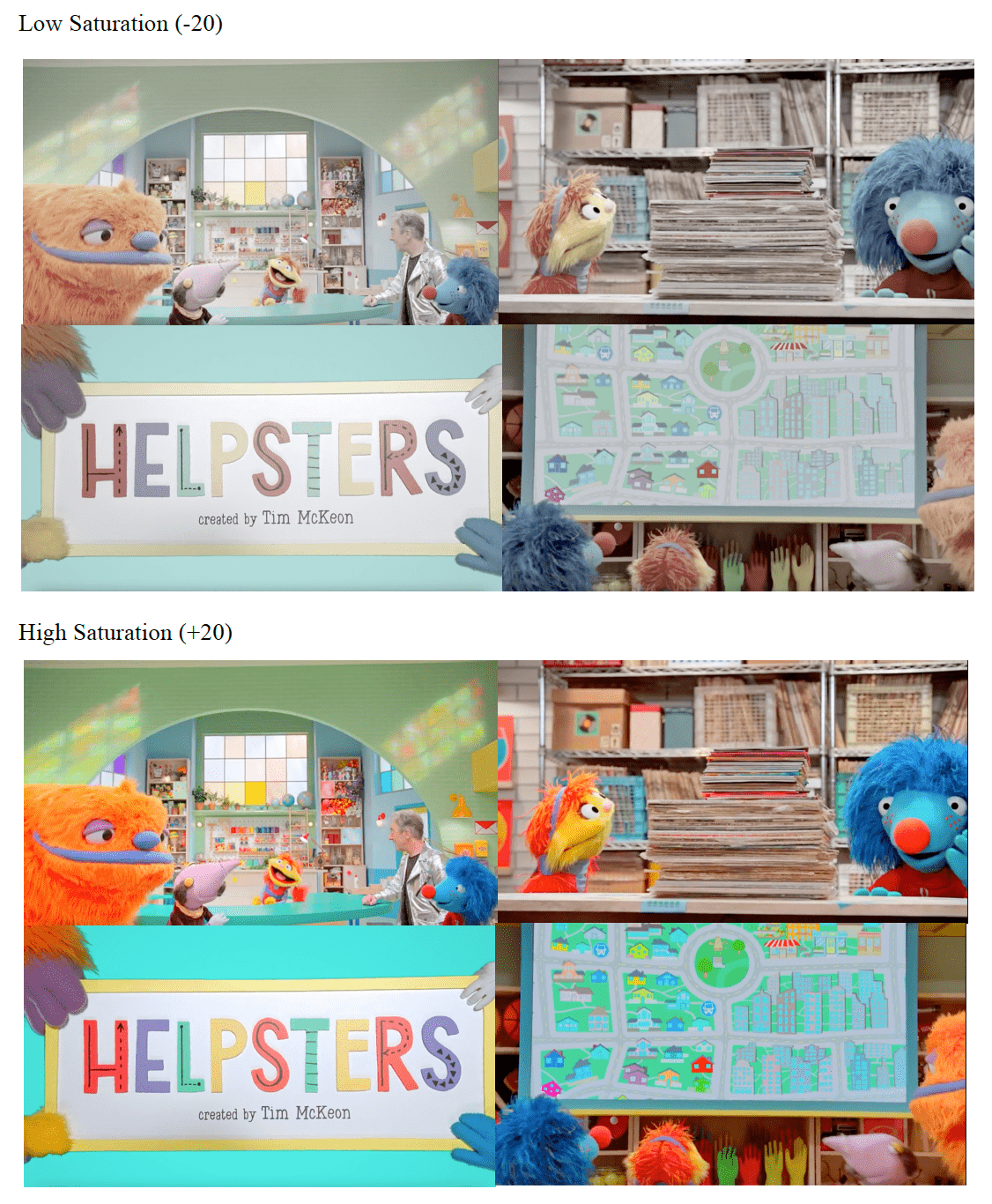
The Feelings Game
The other group is testing the impact of bilingualism on young children’s ability to integrate a speaker’s tone of voice into the meaning of the words they say. Generally, adults focus more on the tone of voice, while children focus more on the words. Because bilingual children have more opportunities to reflect on the meaning of speech in multiple conversation communities, they may be more attuned to features like tone of voice. In the research task, children are asked to point to the smile or frown face if they think the speaker of a recorded message is happy or sad. Sometimes the words and the tone of voice are congruent (e.g., a sentence about getting a treat said in a positive tone) and sometimes they are congruent (e.g., a sentence about losing a favorite item said in a positive tone). To complicate the situation slightly, the voices are sometimes adults and sometimes children, and the children are asked to also indicate whether the speaker is an adult or child. The research team hopes to determine whether monolingual and bilingual children in the 3-6 year old age range are able to integrate tone of voice into their judgements of the emotion conveyed in messages, as well as whether having the additional task of judging the age of the speaker impacts their performance.

Watch for posters with the results of these studies to be posted after the semester ends!
April 2024
The Shapes Game
Psychology Graduate Student Ricky WonJoon Choi, together with undergraduate research assistants Sungjung Bok and LiLi DiMuzio, are playing The Shapes Game with children ranging in age from 3 to 6 years so they can discover age-related changes in children’s use of associations to make causal inferences. The data from the Children’s School will be compared to college students’ performance on a similar set of tasks.
Young children’s environments are filled with information about correlations between things that go together. For example, a common children’s song says, “The wheels on the bus go round and round.” This song teaches children the association between a bus and wheels, and another association between wheels and their motion of going round and round. However, the song itself doesn’t teach children whether the wheels cause the bus to move. In cases like this, children must generalize over common associations to infer how the world works.
The research team is exploring children’s ability to reason about their world by investigating how children engage in associative learning to make causal inferences with novel digital objects.
In The Shapes Game, the child completes four tasks involving geometric shapes that are animated on a computer screen. All tasks require children to generalize between two associations that are indirectly related but never directly seen together. By examining the choices a child makes in these games and whether a child’s choice pattern stays consistent or changes across task type (Figures 1~3 vs. Figures 4~6) and task condition (whether the first object contacts or does not contact the second object), the research team can better understand whether young children’s inferences and predictions are genuinely causal (because of the direct contact) or simply associative (close in space or time).

Children are first told that red squares and purple diamonds go together, while green cylinders and yellow circles go together, as shown in Figure 1. They are then shown animations (Figure 2) in which an object descends from the top of the screen and contacts (or does not contact) the object at the bottom and either causes a sound and change in color or not. They are then shown two new objects (the blue triangle objects) and asked to predict which object will cause the same reaction (Figure 3). If children predict that the blue triangle with the purple diamond will cause the same reaction as the red square, then they are using the initial association to make a causal inference.

In the second type of task, the object interactions are more like pushing, but the association between the inner and outer objects is similar, with each large shape always going together with the same smaller shape, as shown in Figure 4. Children are then shown animated stimuli (Figure 5) in which an object from the left of the screen moves into contact with (or does not contact) an object on the right and either causes the second object to move or not.
As in the first type of task, they are then shown two new objects and asked to predict which object will cause the same reaction, shown in Figure 6. Multiple trials follow the same pattern. Here again, children could use the initial association to make causal inferences, and the researchers are interested in age-related changes in children’s inference patterns.




